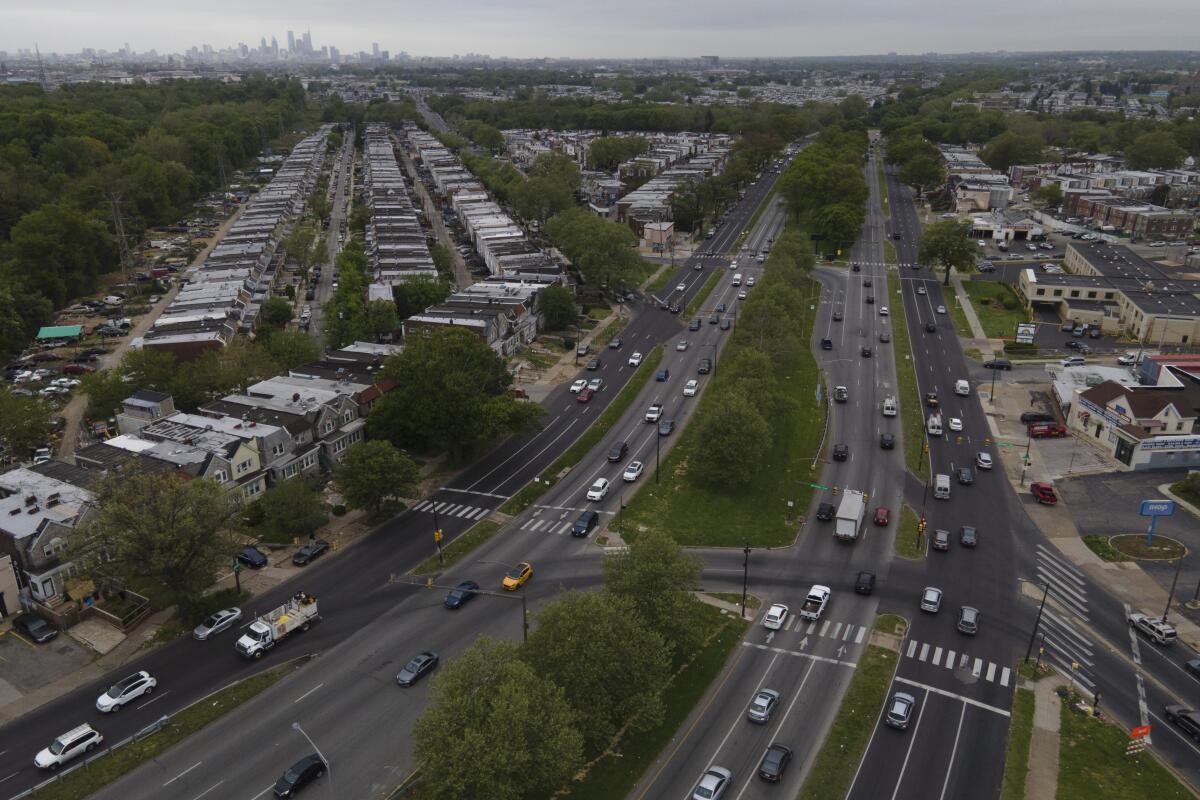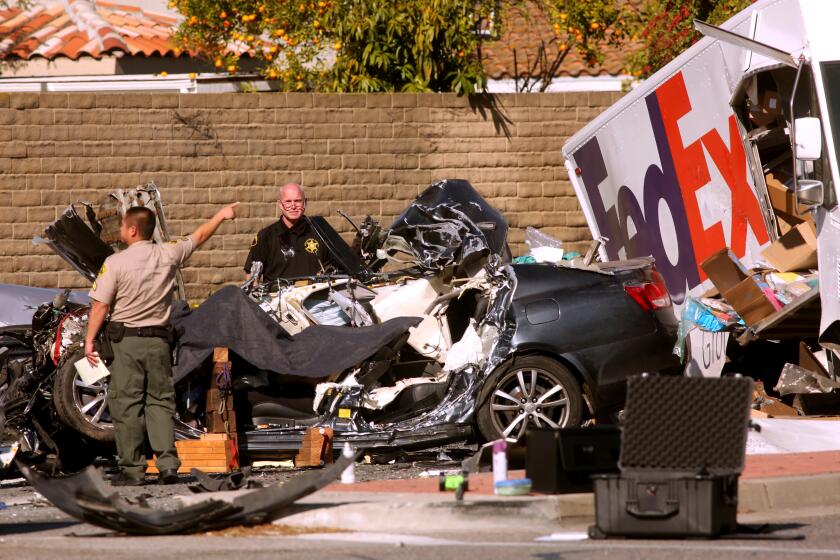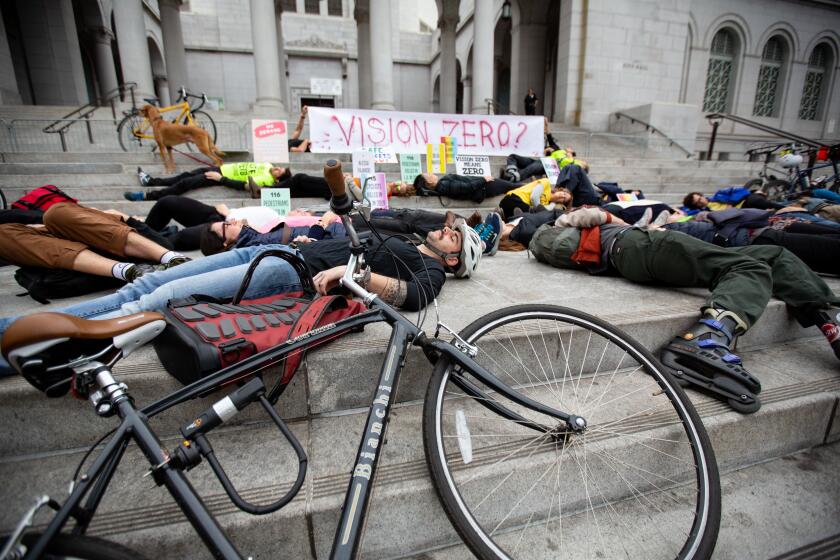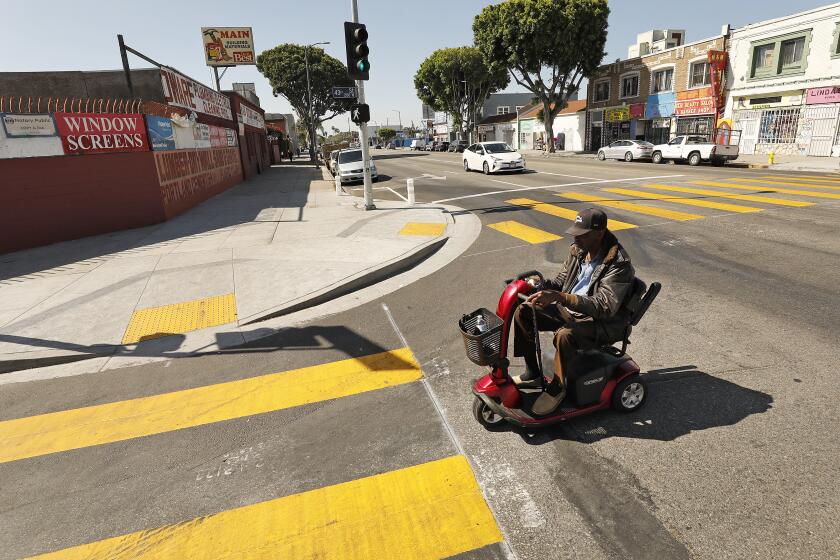A surge in U.S. traffic deaths puts focus on one Philadelphia road

- Share via
PHILADELPHIA — Just one more step and the stroller would have been on the curb.
The thought haunts Latanya Byrd years after a driver racing down Roosevelt Boulevard in Philadelphia struck and killed her 27-year-old niece, Samara Banks, and three of Banks’ young sons as they crossed the 12-lane road. Today, many of the conditions that led to the fatal 2013 crash still exist.
Since the crash, Byrd became an advocate for safer streets, fighting to get automated speed cameras placed along the boulevard where 10% to 13% of the city’s traffic fatalities happened each year prior to the COVID-19 pandemic, city officials said.
And now, amid a national surge in traffic fatalities that federal officials have called a crisis and studies showing Black communities have been hit even harder during the pandemic, plans to redesign the city’s “corridor of death” — as some residents and safety advocates call Roosevelt— could be gaining traction.
Roosevelt Boulevard is an almost 14-mile maze of chaotic traffic patterns that passes through some of the city’s most diverse neighborhoods and census tracts with the highest poverty rates. Driving can be dangerous with cars traversing between inner and outer lanes, but biking or walking on the boulevard can be even worse with some pedestrian crossings longer than a football field and taking four light cycles to cross.
“You would not design a street or a road like that today,” said Christopher Puchalsky, policy director for Philadelphia’s Office of Transportation, Infrastructure and Sustainability. “It feels like an expressway, but it’s in the middle and between neighborhoods.”
Roosevelt Boulevard was first designed in the early 1900s, but as the northeast neighborhoods grew and it was connected to a major highway in the 1950s, lanes were repeatedly added to handle the growing number of cars.
Many of the city’s ideas for fixing Roosevelt have been championed under new federal strategies. In the wake of increasing fatalities, Transportation Secretary Pete Buttigieg has pushed a “safe system” approach, encouraging cities and states to take into account more than just driver behavior when designing roads.
U.S. Transportation Secretary Pete Buttigieg releases a plan that emphasizes moving people safely, not cars quickly.
The Biden administration also created funding for safety improvements, including the bipartisan infrastructure law and a $5-billion federal aid package to cities over the next five years. Federal officials have pledged to prioritize equity when making funding decisions in the wake of a disproportionate 23% jump in Black traffic fatalities in 2020.
“We’ll certainly remind the federal government when we are applying for grants of the equity priorities that the leadership has set out,” Puchalsky said.
Kelley Yemen, director of Philadelphia’s Complete Streets program, said the city is hoping for federal money to begin a long-term redesign of Roosevelt outlined in a study released in 2019. The two options would either make the center lanes a restricted expressway or cut speeds and convert car lanes to bicycle and transit lanes. Both carry billion-dollar price tags.
The study includes a series of smaller projects to improve safety at high-fatality stretches on the road by 2025, some already started, but residents are skeptical.
Eva Gbaa has been impatient to see changes. Her 17-year-old nephew, John “JJ” Gbaa Jr., was killed in a November 2018 hit-and-run as he tried to cross Roosevelt while walking home after hanging out with friends. He was alone at the time, and a lot of the circumstances of the crash were unknown.
A passerby found JJ and called the police, but he died at a hospital. No arrest has been made, and the family still agonizes over how someone could leave the big-hearted boy to die.
“JJ would ask me for money ... but I didn’t know until his friends told me after he passed that he would buy them food if they didn’t have any,” said John Gbaa Sr., JJ’s father. “He loved people. He’d give out his last dollar to his friends.”
Traffic deaths climbed again in Los Angeles in 2021, raising doubts about Mayor Eric Garcetti’s program to end such fatalities by 2025.
JJ and his father had moved to Philadelphia in 2017 to be closer to family, and JJ was making huge strides in school. He loved being near his cousins, and he would hang on his aunt as she cooked traditional African rice dishes.
“He would say, ‘Auntie, when I graduate, I will go to college and then I will take care of you.’ But he never had the chance,” Eva Gbaa said, tamping down tears. “I hope, I hope they do something to make sure no family goes through this, so it doesn’t happen again.”
The family has started a school in JJ’s honor in their home country of Liberia, the John G. Gbaa Jr. Academy for kindergarten through eighth grade, in hopes of giving his dream of education to others. They pay the teachers and send food, clothing and books to the students with the help of small donations.
Around Philadelphia, aggressive driving during the pandemic drove fatalities to 156 in 2020, a sharp increase from 90 deaths in 2019. Preliminary data from the Philadelphia Police Department showed a decrease in 2021 to 133 fatalities, still above pre-pandemic levels.
The data don’t include the race or ethnicity of the people killed, but an Associated Press analysis showed fatalities in neighborhoods where more than 70% of residents are people of color increased from about 50% in 2019 to more than 67% in 2021. The number of accidents happening in the poorest neighborhoods also increased slightly.
Sonia Szczesna, director of active transportation for the Tristate Transportation Campaign, a nonprofit transportation advocacy organization, said Black and brown communities and low-income communities are often the most affected by high-fatality roads.
“They divide these communities, and often residents have to travel these roadways by bike or by foot without access to high-quality public transportation. So there is an inequity in this infrastructure,” Szczesna said.
There is an epidemic of dying while walking, and it affects people of color and poor people disproportionately
Data for the first four months of 2022 showed more pedestrians died on Philadelphia roads so far this year than people in cars. And hit-and-runs were higher in the first four months of this year than the same time frame in the previous two years, worrying police and other city officials.
But fatalities on Roosevelt stayed steady during the pandemic rather than increasing, Yemen said, largely because, she believes, of the pilot speed cameras.
Byrd, who co-founded the nonprofit advocacy group Families for Safe Streets, lobbied hard for the speed cameras, writing hundreds of personal letters to legislators telling them about her niece and her kids. The cameras went live at eight intersections in June 2020, but only after state legislation, a city ordinance and negotiations with the Philadelphia Parking Authority, which manages the program.
More than 224,000 warning tickets for driving more than 11 mph over the speed limit were issued in the first 30 days of a 60-day warning period, but by February 2021, that number had dropped to fewer than 17,000 tickets, according to data from the parking authority. Overall, speeding is down by more than 91% on the road, city and parking authority officials said.
Despite the impact, the cameras will sunset in 2023 unless extended by the Legislature.
The Federal Highway Administration gave states the green light this year to tap into federal funding to install speed cameras, saying they can reduce the number of injury crashes by 50%.
Byrd’s niece Samara Banks was 21 and pregnant with her first child in 2007 when she found a four-bedroom house a few blocks south of Roosevelt Boulevard.
Her family had reservations because she’d have to cross the boulevard any time she wanted to visit. But Banks’ mother had just died and she needed the larger home so she could take in her four younger siblings and raise her own family.
Byrd said Banks was the kind of mom and aunt who always had something planned. “At all of the family get-togethers, she would always get all the kids in a circle and have them playing games and doing dances, or she’d make up these little skits for them to do. She always had a plan and the kids always came first,” Byrd said.
After spending a hot July day visiting and swimming and having water balloon fights with the kids, Banks decided to walk home rather than calling a cab to take her the mile across Roosevelt, as she usually did.
She was pushing her 7-month-old, Saa’mir Williams, and 23-month-old, Saa’sean Williams, in a double stroller. Her 4-year-old, Saa’deem Griffin, was holding onto the stroller and walking beside her.
Witnesses told police that two cars had been racing, weaving between other cars and speeding down the boulevard. One of the drivers lost control and slammed into the family, throwing Banks more than 200 feet and crumpling the stroller. She and the three children died.
Banks’ younger sister and 5-year-old son, Saa’yon Griffin, were walking ahead and survived the crash.
Officials have since installed a traffic signal and pedestrian crossing at the intersection, renamed Banks Way in honor of the young mother. The two men accused of racing were eventually convicted or pleaded guilty to charges in the deaths. One of the men was a teenager when his own mother had died crossing Roosevelt Boulevard.
“It was hard. I would tell Saa’yon he needed to be strong, and I remember there was this once he just stomped his foot and said no,” Byrd said. “He told me he was tired of being strong and he just wanted his mom and his brothers back. We all do.”
More to Read
Sign up for Essential California
The most important California stories and recommendations in your inbox every morning.
You may occasionally receive promotional content from the Los Angeles Times.













